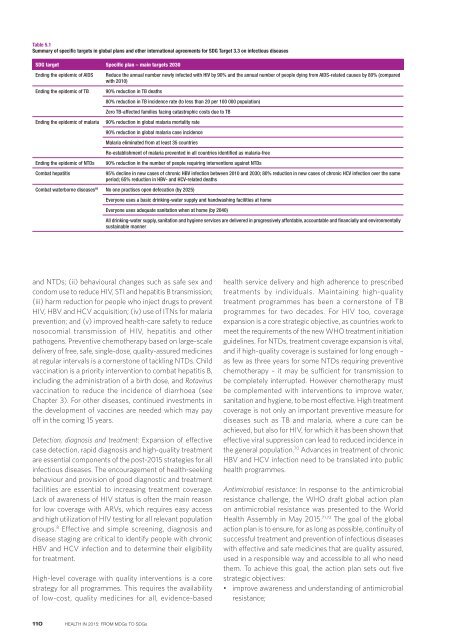Create successful ePaper yourself
Turn your PDF publications into a flip-book with our unique Google optimized e-Paper software.
Table 5.1<br />
Summary of specific targets in global plans and other international agreements for SDG Target 3.3 on infectious diseases<br />
SDG target Specific plan – main targets 2030<br />
Ending the epidemic of AIDS<br />
Ending the epidemic of TB<br />
Ending the epidemic of malaria<br />
Ending the epidemic of NTDs<br />
Combat hepatitis<br />
Reduce the annual number newly infected with HIV by 90% and the annual number of people dying <strong>from</strong> AIDS-related causes by 80% (compared<br />
with 2010)<br />
90% reduction in TB deaths<br />
80% reduction in TB incidence rate (<strong>to</strong> less than 20 per 100 000 population)<br />
Zero TB-affected families facing catastrophic costs due <strong>to</strong> TB<br />
90% reduction in global malaria mortality rate<br />
90% reduction in global malaria case incidence<br />
Malaria eliminated <strong>from</strong> at least 35 countries<br />
Re-establishment of malaria prevented in all countries identified as malaria-free<br />
90% reduction in the number of people requiring interventions against NTDs<br />
95% decline in new cases of chronic HBV infection between 2010 and 2030; 80% reduction in new cases of chronic HCV infection over the same<br />
period; 65% reduction in HBV- and HCV-related deaths<br />
Combat waterborne diseases 69 No one practises open defecation (by 2025)<br />
Everyone uses a basic drinking-water supply and handwashing facilities at home<br />
Everyone uses adequate sanitation when at home (by 2040)<br />
All drinking-water supply, sanitation and hygiene services are delivered in progressively affordable, accountable and financially and environmentally<br />
sustainable manner<br />
and NTDs; (ii) behavioural changes such as safe sex and<br />
condom use <strong>to</strong> reduce HIV, STI and hepatitis B transmission;<br />
(iii) harm reduction for people who inject drugs <strong>to</strong> prevent<br />
HIV, HBV and HCV acquisition; (iv) use of ITNs for malaria<br />
prevention; and (v) improved health-care safety <strong>to</strong> reduce<br />
nosocomial transmission of HIV, hepatitis and other<br />
pathogens. Preventive chemotherapy based on large-scale<br />
delivery of free, safe, single-dose, quality-assured medicines<br />
at regular intervals is a corners<strong>to</strong>ne of tackling NTDs. Child<br />
vaccination is a priority intervention <strong>to</strong> combat hepatitis B,<br />
including the administration of a birth dose, and Rotavirus<br />
vaccination <strong>to</strong> reduce the incidence of diarrhoea (see<br />
Chapter 3). For other diseases, continued investments in<br />
the development of vaccines are needed which may pay<br />
off in the coming 15 years.<br />
Detection, diagnosis and treatment: Expansion of effective<br />
case detection, rapid diagnosis and high-quality treatment<br />
are essential components of the post-2015 strategies for all<br />
infectious diseases. The encouragement of health-seeking<br />
behaviour and provision of good diagnostic and treatment<br />
facilities are essential <strong>to</strong> increasing treatment coverage.<br />
Lack of awareness of HIV status is often the main reason<br />
for low coverage with ARVs, which requires easy access<br />
and high utilization of HIV testing for all relevant population<br />
groups. 8 Effective and simple screening, diagnosis and<br />
disease staging are critical <strong>to</strong> identify people with chronic<br />
HBV and HCV infection and <strong>to</strong> determine their eligibility<br />
for treatment.<br />
High-level coverage with quality interventions is a core<br />
strategy for all programmes. This requires the availability<br />
of low-cost, quality medicines for all, evidence-based<br />
health service delivery and high adherence <strong>to</strong> prescribed<br />
treatments by individuals. Maintaining high-quality<br />
treatment programmes has been a corners<strong>to</strong>ne of TB<br />
programmes for two decades. For HIV <strong>to</strong>o, coverage<br />
expansion is a core strategic objective, as countries work <strong>to</strong><br />
meet the requirements of the new WHO treatment initiation<br />
guidelines. For NTDs, treatment coverage expansion is vital,<br />
and if high-quality coverage is sustained for long enough –<br />
as few as three years for some NTDs requiring preventive<br />
chemotherapy – it may be sufficient for transmission <strong>to</strong><br />
be completely interrupted. However chemotherapy must<br />
be complemented with interventions <strong>to</strong> improve water,<br />
sanitation and hygiene, <strong>to</strong> be most effective. High treatment<br />
coverage is not only an important preventive measure for<br />
diseases such as TB and malaria, where a cure can be<br />
achieved, but also for HIV, for which it has been shown that<br />
effective viral suppression can lead <strong>to</strong> reduced incidence in<br />
the general population. 70 Advances in treatment of chronic<br />
HBV and HCV infection need <strong>to</strong> be translated in<strong>to</strong> public<br />
health programmes.<br />
Antimicrobial resistance: In response <strong>to</strong> the antimicrobial<br />
resistance challenge, the WHO draft global action plan<br />
on antimicrobial resistance was presented <strong>to</strong> the World<br />
Health Assembly in May 2015. 71,72 The goal of the global<br />
action plan is <strong>to</strong> ensure, for as long as possible, continuity of<br />
successful treatment and prevention of infectious diseases<br />
with effective and safe medicines that are quality assured,<br />
used in a responsible way and accessible <strong>to</strong> all who need<br />
them. To achieve this goal, the action plan sets out five<br />
strategic objectives:<br />
• improve awareness and understanding of antimicrobial<br />
resistance;<br />
110 HEALTH IN 2015: FROM MDGs TO SDGs


